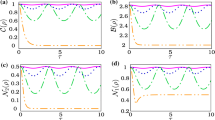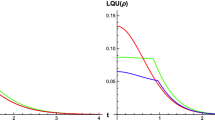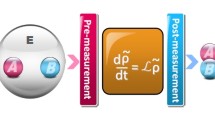Abstract
The effect of measurement attributes (quantum level of precision, finite duration) on the classical and quantum correlations is analyzed for a pair of qubits immersed in a common reservoir. We show that the quantum discord is enhanced as the precision of the measuring instrument is increased, and both the classical correlation and the quantum discord experience noticeable changes during finite-time measurements performed on a neighboring partition of the entangled system. The implication of these results on the “information–disturbance relationship” is examined, with critical analysis of the delicate roles played by quantum non-locality and non-Markovian dynamics in the violation of this relationship, which appears surprisingly for a range of measurement attributes. This work highlights that the fundamental limits of quantum mechanical measurements can be altered by exchanges of non-classical correlations such as the quantum discord with external sources, which has relevance to cryptographic technology.








Similar content being viewed by others
References
von Neumann, J.: Mathematical Foundations of Quantum Mechanics. Princeton University Press, Princeton (1955)
Zeh, H.D.: On the interpretation of measurement in quantum theory. Found. Phys. 1(1), 69–76 (1970)
Kofman, A.G., Kurizki, G.: Acceleration of quantum decay processes by frequent observations. Nature 405(6786), 546–550 (2000)
Misra, B., Sudarshan, E.C.G.: The Zeno’s paradox in quantum theory. J. Math. Phys. 18, 756 (1977)
Facchi, P., Pascazio, S.: Quantum Zeno dynamics: mathematical and physical aspects. J. Phys. A: Math. Theor. 41, 493001 (2008)
Facchi, P., Pascazio, S.: Quantum Zeno subspaces. Phys. Rev. Lett. 89, 080401 (2002)
Braginsky, V.B., Khalili, F.Ya.: In: Thorne, K.S. (ed.) Quantum Measurement. Cambridge University Press, Cambridge (1992); and references cited therein
Mensky, M.B.: Continuous Quantum Measurements and Path-Integrals. Institute of Physics Publishers, Bristol, Philadelphia (1993)
Zurek, W.H.: Decoherence and the transition from quantum to classical. Phys. Today 44(10), 36 (1991)
Zurek, W.H.: Environment-induced superselection rules. Phys. Rev. D 26, 1862 (1982)
Schlosshauer, M.: Decoherence and the Quantum-to-Classical Transition. Springer, Berlin (2008)
Ruskov, R., Korotkov, A.N.: Entanglement of solid-state qubits by measurement. Phys. Rev. B 67, 241305(R) (2003)
Englert, B.G.: On Quantum Theory. arXiv:quant-ph:arXiv:1308.5290 (2013)
Ollivier, H., Zurek, W.H.: Quantum discord: a measure of the quantumness of correlations. Phys. Rev. Lett. 88, 017901 (2001)
Henderson, L., Vedral, V.: Classical, quantum and total correlations. J. Phys. A 34, 6899 (2001)
Vedral, V.: Classical correlations and entanglement in quantum measurements. Phys. Rev. Lett. 90, 050401 (2003)
Coffman, V., Kundu, J., Wootters, W.K.: Distributed entanglement. Phys. Rev. A 61, 052306 (2000)
Brodutch, A., Terno, D.R.: Quantum discord, local operations, and Maxwell’s demons. Phys. Rev. A 81, 062103 (2010)
Maziero, J., Celeri, L.C., Serra, R.M., Vedral, V.: Classical and quantum correlations under decoherence. Phys. Rev. A 80, 044102 (2009)
Mazzola, L., Piilo, J., Maniscalco, S.: Sudden transition between classical and quantum decoherence. Phys. Rev. Lett. 104, 200401 (2010)
Ciliberti, L., Rossignoli, R., Canosa, N.: Quantum discord in finite XY chains. Phys. Rev. A 82, 042316 (2010)
Datta, A., Shaji, A., Caves, C.M.: Quantum discord and the power of one qubit. Phys. Rev. Lett. 100, 050502 (2008)
Sacchi, M.F.: Information–disturbance tradeoff in estimating a maximally entangled state. Phys. Rev. Lett. 96, 220502 (2006)
Maccone, L.: Information–disturbance tradeoff in quantum measurements. Phys. Rev. A 73, 042307 (2006)
D’Ariano, G.M.: On the Heisenberg principle, namely on the information–disturbance trade-off in a quantum measurement. Fortschritte der Physik 51, 318–330 (2003)
Buscemi, F., Sacchi, M.F.: Information–disturbance trade-off in quantum-state discrimination. Phys. Rev. A 74, 052320 (2006)
Maccone, L.: Entropic information–disturbance tradeoff. EPL 77, 40002 (2007)
Heisenberg, W.: The Physical Principles of the Quantum Theory. Dover, New York (1930)
Rozema, L.A., Darabi, A., Mahler, D.H., Hayat, A., Soudagar, Y., Steinberg, A.M.: Violation of Heisenberg’s measurement–disturbance relationship by weak measurements. Phys. Rev. Lett. 109, 100404 (2012)
Wolfgramm, F., Vitelli, C., Beduini, F.A., Godbout, N., Mitchell, M.W.: Entanglement-enhanced probing of a delicate material system. Nat. Photonics 7, 28 (2013)
Thilagam, A.: Exceptional points and quantum correlations in precise measurements. J. Phys. A 45, 444031 (2012)
Feynman, R.P., Hibbs, A.R.: Quantum Mechanics and Path Integrals. McGraw-Hill, New York (1965)
Feynman, R.P.: Space-time approach to non-relativistic quantum mechanics. Rev. Mod. Phys. 20, 367 (1948)
Mensky, M.B.: Quantum restrictions for continuous observation of an oscillator. Phys. Rev. D 20, 384 (1979)
Mensky, M.B.: Quantum restrictions for continuous observation of an oscillator. Sov. Phys. JETP 50, 667 (1979)
Mensky, M.B., Onofrio, R., Presilla, C.: Optimal monitoring of position in nonlinear quantum systems. Phys. Rev. Lett. 70, 2825 (1993)
Mensky, M.B., Onofrio, R., Presilla, C.: Continuous quantum monitoring of position of nonlinear oscillators. Phys. Lett. A 161, 236–240 (1991)
Onofrio, R., Presilla, C., Tambini, U.: Quantum Zeno effect with the Feynman–Mensky path-integral approach. Phys. Lett. A 183, 135–140 (1993)
Tambini, U., Presilla, C., Onofrio, R.: Dynamics of quantum collapse in energy measurements. Phys. Rev. A 51, 967 (1995)
Audretsch, J., Mensky, M.: Continuous fuzzy measurement of energy for a two-level system. Phys. Rev. A 56, 44 (1997)
Heiss, W.D.: Repulsion of resonance states and exceptional points. Phys. Rev. E 61, 929 (2000)
Salles, A., de Melo, F., Almeida, M.P., Hor-Meyll, M., Walborn, S.P., Ribeiro, P.S., Davidovich, L.: Experimental investigation of the dynamics of entanglement: sudden death, complementarity, and continuous monitoring of the environment. Phys. Rev. A 78, 022322 (2008)
Sudarshan, E.C.G., Mathews, P.M., Rau, J.: Stochastic dynamics of quantum-mechanical systems. Phys. Rev. 121, 920–924 (1961)
Kraus, K.: States, Effects, and Operations: Fundamental Notions of Quantum Theory. Springer, Berlin (1983)
Bell, J.S.: On the Einstein–Podolsky–Rosen paradox. Physics 1, 195–200 (1964)
Clauser, J.F., Horne, M.A., Shimony, A., Holt, R.A.: Proposed experiment to test local hidden-variable theories. Phys. Rev. Lett. 23, 880–884 (1969)
Bellomo, B., Franco, R.L., Compagno, G.: Dynamics of non-classically-reproducible entanglement. Phys. Rev. A 78, 062309 (2008)
Galve, F., Giorgi, G.L., Zambrini, R.: Orthogonal measurements are almost sufficient for quantum discord of two qubits. Europhys. Lett. (EPL) 96, 40005 (2011)
Szilard, L.: Uber die Entropieverminderung in einem thermodynamischen System bei Eingriffen intelligenter Wesen. Zeitschrift fr Physik 53(11–12), 840–856 (1929)
Jozsa, R.: Fidelity for mixed quantum states. J. Mod. Opt. 41(12), 2315–2323 (1994)
Anandan, J., Aharonov, Y.: Geometry of quantum evolution. Phys. Rev. Lett. 65, 1697 (1990)
Wolf, M.M., Eisert, J., Cubitt, T.S., Cirac, J.I.: Assessing non-Markovian quantum dynamics. Phys. Rev. Lett. 101, 150402 (2008)
Rajagopal, A.K., Devi, A.U., Rendell, R.W.: Kraus representation of quantum evolution and fidelity as manifestations of Markovian and non-Markovian forms. Phys. Rev. A 82, 042107 (2010)
Breuer, H.P., Laine, E.M., Piilo, J.: Measure for the degree of non-Markovian behavior of quantum processes in open systems. Phys. Rev. Lett. 103, 210401 (2009)
Hall, M.A., Altepeter, J.B., Kumar, P.: Drop-in compatible entanglement for optical-fiber networks. Opt. Express 17, 14558–14566 (2009)
Tittel, W., Brendel, J., Zbinden, H., Gisin, N.: Violation of Bell inequalities by photons more than 10 km apart. Phys. Rev. Lett. 81, 3563 (1998)
Caruso, F., Chin, A.W., Datta, A., Huelga, S.F., Plenio, M.B.: Highly efficient energy excitation transfer in light-harvesting complexes: the fundamental role of noise-assisted transport. J. Chem. Phys. 131, 105106–105106 (2009)
Rebentrost, P., Mohseni, M., Aspuru-Guzik, A.: Role of quantum coherence and environmental fluctuations in chromophoric energy transport. J. Phys. Chem. B 113, 9942–9947 (2009)
Thilagam, A.: Non-Hermitian exciton dynamics in a photosynthetic unit system. J. Chem. Phys. 136, 065104 (2012)
Thilagam, A.: Multipartite entanglement in the Fenna–Matthews–Olson (FMO) pigment–protein complex. J. Chem. Phys. 136, 175104 (2012)
Thilagam, A., Usha Devi, A.R.: Non-Markovianity and Clauser–Horne–Shimony–Holt (CHSH)-Bell inequality violation in quantum dissipative systems. J. Chem. Phys. 137, 215103–215103 (2012)
Caram, J.R., Lewis, N.H., Fidler, A.F., Engel, G.S.: Signatures of correlated excitonic dynamics in two-dimensional spectroscopy of the Fenna–Matthew–Olson photosynthetic complex. J. Chem. Phys. 137, 024507 (2012)
Acknowledgments
This research was undertaken on the NCI National Facility in Canberra, Australia, which is supported by the Australian Commonwealth Government. The author gratefully acknowledges the support of the Julian Schwinger Foundation Grant, JSF-12-06-0000. The author would like to thank the anonymous referees for helpful comments.
Author information
Authors and Affiliations
Corresponding author
Rights and permissions
About this article
Cite this article
Thilagam, A. Violation of the “information–disturbance relationship” in finite-time quantum measurements. Quantum Inf Process 13, 151–169 (2014). https://doi.org/10.1007/s11128-013-0673-y
Received:
Accepted:
Published:
Issue Date:
DOI: https://doi.org/10.1007/s11128-013-0673-y




